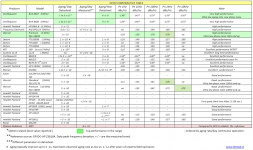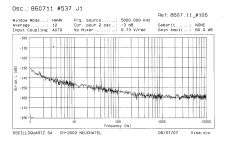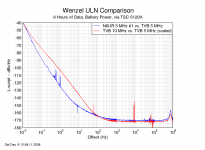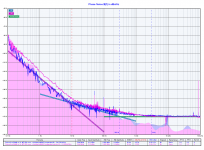--
Sorry, but it ain't worth my time to search for messages the OLD FASHIONED WAY.
If you want to impress, try using hyperlinks.
PSSSSSTT: That's why the Internet was invented 😉
Hyperlink to project documents was added to the first post of the thread.
And yes, last PDF update on 2017 May 6th, no reason to update these files, nothing has been changed.
Next update with new documents as soon as the new oscillators and doubler will be ready.
de rigueur
Links, to another post, don't work for IMPORTANT project docs. You should post direct links to all important docs in the first post. That's de rigueur.Hyperlink to project documents was added to the first post of the thread.
Links, to another post, don't work for IMPORTANT project docs. You should post direct links to all important docs in the first post. That's de rigueur.
There is a precise reason, the first post can accommodate not more than 10 documents, that I would reserve for the incoming projects.
Moreover, hyperlinks help you jumping from a page to another, so it does not seem a great issue jumping from post #1 to post #1506 to open the documents you are interested on, again via hyperlink.
Links, to another post, don't work for IMPORTANT project docs. You should post direct links to all important docs in the first post. That's de rigueur.
I'm just happy Andrea is doing this. I learn a lot following this thread. No one is required to follow the thread. If the tidy up the documents into one page with links to everything is so important then volunteer to do it yourself and maintain it! When you are done have Andrea revise it to make sure it ok and he can add the link to your page from the first page of this thread? Or start a wiki page where you and all interested organize the documentation? Or start a new thread to discuss how disorganized the documentation is on this thread and how to improve it?*
KHashmi316... with respect, this project may not be for you. I have implemented these clocks and am very happy with the results. But, it is a project that requires some conviction. If you are finding frustration at this point it may get worse before it gets better.--
Sorry, but it ain't worth my time to search for messages the OLD FASHIONED WAY.
If you want to impress, try using hyperlinks.
PSSSSSTT: That's why the Internet was invented 😉
The challenges include:
-it costs a fair bit, but in the outcome ranges from totally satisfied to unable to debug
-the oven can be frustrating to get assembled and get working properly
-the wait time to receive the crystal from Laptech can be months
Again I say this as one of the many people happy with Andre's GB and the help of the community.
But it may not be for everyone. You seem to be off to a rough start and it may not be your cup of tea.
KHashmi316... with respect, this project may not be for you. I have implemented these clocks and am very happy with the results. But, it is a project that requires some conviction. If you are finding frustration at this point it may get worse before it gets better.
The challenges include:
-it costs a fair bit, but in the outcome ranges from totally satisfied to unable to debug
-the oven can be frustrating to get assembled and get working properly
-the wait time to receive the crystal from Laptech can be months
Again I say this as one of the many people happy with Andre's GB and the help of the community.
But it may not be for everyone. You seem to be off to a rough start and it may not be your cup of tea.
Nice post.
Have we only seen a standalone "Thank you" from this guy ? 🙁
Is this good ol' "Eldham"? 🙂
//
Last edited:
I was thinking more :
https://www.diyaudio.com/forums/dig...-soekris-dac-implementations.html#post4184471
//
https://www.diyaudio.com/forums/dig...-soekris-dac-implementations.html#post4184471
//
So not your Ol' good Eldham but just a nice denunciation purpose perhaps ? Class and education, elegance are even rarer I thought 😉
What I' sure is I'm not your Old Ham, your Hold Dam cheese... whatever.
What I' sure is I'm not your Old Ham, your Hold Dam cheese... whatever.
Last edited:
KHashmi316... with respect, this project may not be for you. I have implemented these clocks and am very happy with the results. But, it is a project that requires some conviction. If you are finding frustration at this point it may get worse before it gets better.
The challenges include:
-it costs a fair bit, but in the outcome ranges from totally satisfied to unable to debug
-the oven can be frustrating to get assembled and get working properly
-the wait time to receive the crystal from Laptech can be months
Again I say this as one of the many people happy with Andre's GB and the help of the community.
But it may not be for everyone. You seem to be off to a rough start and it may not be your cup of tea.
The TWTMC project is is a bit strange. The PDFs are very well laid out, compact, and succinct. Quite impressive.
The TWTMC thread (this thread) is a complete mess. I've already noted the inability to locate key documents.
So this "asymmetry" -- PDFs good, thread bad -- is confusing. And THAT confusion--fwiw -- can lead back to doubting the TWTMC topology itself. That is ... if the thread is mess, might this not be a warning sign for how effective the circuit might be?
The TWTMC project is is a bit strange. The PDFs are very well laid out, compact, and succinct. Quite impressive.
The TWTMC thread (this thread) is a complete mess. I've already noted the inability to locate key documents.
So this "asymmetry" -- PDFs good, thread bad -- is confusing. And THAT confusion--fwiw -- can lead back to doubting the TWTMC topology itself. That is ... if the thread is mess, might this not be a warning sign for how effective the circuit might be?
is only a sign of how the developer has choosen to distribute his time to serve you all ... and that lead back to the little effort you are putting into following 🙂
The TWTMC project is is a bit strange. The PDFs are very well laid out, compact, and succinct. Quite impressive.
The TWTMC thread (this thread) is a complete mess. I've already noted the inability to locate key documents.
So this "asymmetry" -- PDFs good, thread bad -- is confusing. And THAT confusion--fwiw -- can lead back to doubting the TWTMC topology itself. That is ... if the thread is mess, might this not be a warning sign for how effective the circuit might be?
I'm sorry, but that makes no sense to me.
To doubt a design because the thread is confusing??
I'm happy that the documentation is good, as you said. Designers are not
always the best at documentation.
Really not sure why you think this thread is so bad, its seems on par with many others here for popular designs. The threads become long with tangents.
You're basically getting a ton of R&D work for free, so really don't know what you're complaining about.
Randy
I can't comment on the merits of the circuit design, but like most do find the sound quality to be exceptional when compared with commonly available low noise clocks. I reported my positive observations starting at post #1844.That is ... if the thread is mess, might this not be a warning sign for how effective the circuit might be?
Took less than 2 minutes to click advanced search, type in "TWTMC pdf" & "andrea_mori" and then find in the 13th post on the page, an update including all the schematics, boms, and build guides, post #1506 btw.
I'm happy to trade off the tiny amount of effort that took on my part, in return for the staggering effort Andrea has made over the YEARS sharing circuits, organizing numerous group buys, answering hundreds of questions etc etc.
Randy's right, the thread is fine...If Andrea hasn't gotten around to adding useful info to the op yet, oh well.
I'm happy to trade off the tiny amount of effort that took on my part, in return for the staggering effort Andrea has made over the YEARS sharing circuits, organizing numerous group buys, answering hundreds of questions etc etc.
Randy's right, the thread is fine...If Andrea hasn't gotten around to adding useful info to the op yet, oh well.
The TWTMC project is is a bit strange. The PDFs are very well laid out, compact, and succinct. Quite impressive.
The TWTMC thread (this thread) is a complete mess. I've already noted the inability to locate key documents.
So this "asymmetry" -- PDFs good, thread bad -- is confusing. And THAT confusion--fwiw -- can lead back to doubting the TWTMC topology itself. That is ... if the thread is mess, might this not be a warning sign for how effective the circuit might be?
You can evaluate yourself the performance of the new oscillator with a simple comparison.
from left to right:
- SOTA oscillators on the market comparative table
- Oscilloquartz BVA 8607 phase noise plot
- Wenzel ULN phase noise plot
- New Driscoll design phase noise plot (as you can see the noise floor of the measurement instrument overcomes the close-in phase noise of the DUT, 0.1 Hz to 1 Hz)
Take a look at: -130dBc@1Hz and -157.4dBc@10Hz from the carrier, I believe that the plot clearly tells "how effective the circuit might be".
Attachments
Andrea, you are to be commended on this effort, amazing results.
You've managed to extract not only extremely low phase noise close to carrier but also a very low phase noise floor. WRT the latter, this may not
seem that important but once we start multiplying to get 22 or even 45 M, on traditional designs that have sacrificed noise floor to obtain extremely low
close in phase noise then the NF will rise considerably after multiplying.
Recently I have become aware of a new super low phase noise 10 MHz Ref OCXO design by some people at the University of York. This design achieves
the following phase noise specs:
1Hz, -123dBc, 10Hz, -148dBc, 100Hz, -157dBc, 1k, -161dBc etc.
The Allan Dev is <2x10^-13 / 1 sec
Given that for the lowest possible phase noise, especially close to carrier, 5MHz is optimum, then the 'York' OCXO design is *possibly slightly better
but it's a very close call and we must also consider that this design is a collaborative effort by experts in the field. Link to white paper and
full schematic below.
http://eprints.whiterose.ac.uk/141563/1/08540461.pdf
Of interest to note, the 'York' uses a unique transformer coupled, differential OP design with the active device being an SSM2212 low noise 'audio type'
transistor as opposed to the usual RF BJT. One characteristic the SSM device does have is among the lowest 1/f noise for any device I'm aware of being
sub 1Hz. Most RF designers probably wouldn't consider using such a device however the Ft is 300MHz with enough current the high Cob is not such a
problem at 5 to 10MHz and low circuit impedances. Exactly how much the active device 1/f noise translates to close in phase noise, I'm not sure,
hopefully others here can clarify but the white paper alludes to some importance.
Count me in when you do the GB.
PS - If you need any help with a suitable enclosure or mounting let me know, I've got many yrs 2d/3d CAD modelling under the belt.
TCD
You've managed to extract not only extremely low phase noise close to carrier but also a very low phase noise floor. WRT the latter, this may not
seem that important but once we start multiplying to get 22 or even 45 M, on traditional designs that have sacrificed noise floor to obtain extremely low
close in phase noise then the NF will rise considerably after multiplying.
Recently I have become aware of a new super low phase noise 10 MHz Ref OCXO design by some people at the University of York. This design achieves
the following phase noise specs:
1Hz, -123dBc, 10Hz, -148dBc, 100Hz, -157dBc, 1k, -161dBc etc.
The Allan Dev is <2x10^-13 / 1 sec
Given that for the lowest possible phase noise, especially close to carrier, 5MHz is optimum, then the 'York' OCXO design is *possibly slightly better
but it's a very close call and we must also consider that this design is a collaborative effort by experts in the field. Link to white paper and
full schematic below.
http://eprints.whiterose.ac.uk/141563/1/08540461.pdf
Of interest to note, the 'York' uses a unique transformer coupled, differential OP design with the active device being an SSM2212 low noise 'audio type'
transistor as opposed to the usual RF BJT. One characteristic the SSM device does have is among the lowest 1/f noise for any device I'm aware of being
sub 1Hz. Most RF designers probably wouldn't consider using such a device however the Ft is 300MHz with enough current the high Cob is not such a
problem at 5 to 10MHz and low circuit impedances. Exactly how much the active device 1/f noise translates to close in phase noise, I'm not sure,
hopefully others here can clarify but the white paper alludes to some importance.
Count me in when you do the GB.
PS - If you need any help with a suitable enclosure or mounting let me know, I've got many yrs 2d/3d CAD modelling under the belt.
TCD
- Status
- Not open for further replies.
- Home
- Source & Line
- Digital Line Level
- The Well Tempered Master Clock - Building a low phase noise/jitter crystal oscillator



